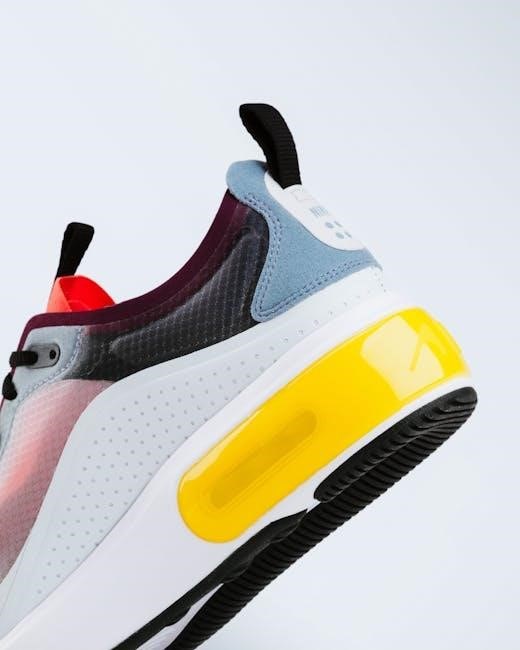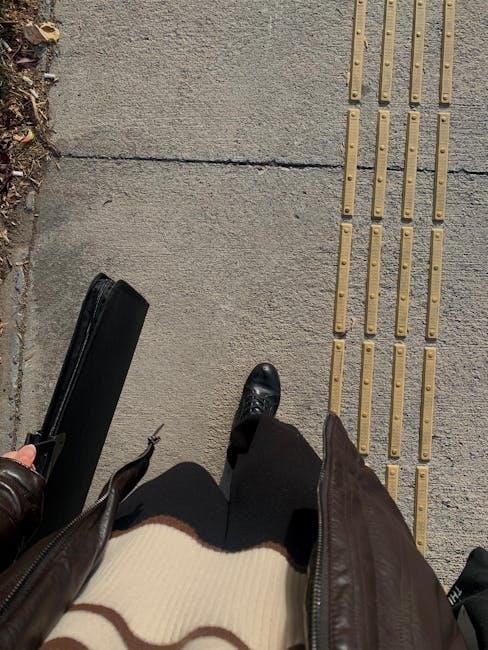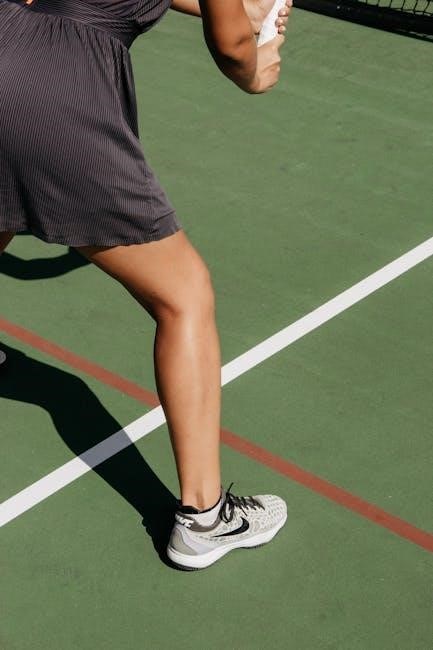Understanding shoe size width is crucial for optimal comfort and fit. This guide explores various sizing systems, measurement techniques, and factors influencing shoe width to help you find your perfect fit.
Overview of Shoe Sizing Systems
Shoe sizing systems vary globally, with the U.S., U.K., and European systems being the most common. These systems primarily measure foot length but often overlook width, leading to fit issues. The U.S. system uses a linear scale, while European sizes are based on the Paris Point system, offering more precise measurements. Women’s and men’s sizes differ significantly due to foot shape and size differences. Despite these variations, shoe width is rarely standardized, causing confusion. Understanding these systems is essential for finding the right fit, especially for those with wider or narrower feet. This guide helps navigate these complexities to ensure comfort and proper shoe fit for all foot types.
Importance of Shoe Width in Comfort and Fit
Shoe width plays a vital role in ensuring comfort and proper fit. While shoe length is often the primary focus, width is equally critical, as it directly impacts how the shoe accommodates the foot’s natural shape. Narrow or wide feet may experience discomfort, blisters, or restricted movement if the shoe width does not align with their foot dimensions. Proper width ensures adequate space for toes to move freely, preventing issues like hammertoes or bunions. Additionally, shoe width affects overall stability, particularly during physical activities, where a snug yet comfortable fit is essential. Ignoring width can lead to poor circulation, fatigue, or even long-term foot health problems. Thus, understanding and prioritizing shoe width is key to achieving optimal comfort and support for daily wear or athletic performance.

How to Measure Your Foot for Shoe Size
Measure your foot using a ruler or tape measure. Place your foot flat on the floor with your heel against a wall for accuracy. Measure length from heel to longest toe and width across the ball of the foot. Use these measurements to determine your shoe size using a size chart. Ensure to measure at the end of the day for the most accurate fit, as feet tend to swell throughout the day. Repeat the process for both feet, as they may differ slightly, and use the larger measurement to ensure comfort. This method helps in selecting shoes that provide the right balance of support and space for optimal comfort.
Tools Needed for Accurate Measurement
To measure your foot accurately, you will need a few simple tools. A flat ruler or a tape measure is essential for determining both the length and width of your foot. Place your foot flat on the floor with your heel against a wall for proper alignment. You may also use a piece of paper and a pen to mark the longest toe and the widest part of your foot for reference. Ensure the ruler or tape measure is aligned straight and level. If possible, use a digital ruler or measuring tool for greater precision. These tools are readily available and will help you obtain accurate measurements for the perfect shoe fit. Proper measurement ensures comfort and prevents issues like tight or loose shoes.
Step-by-Step Guide to Measuring Foot Length
To measure your foot length accurately, start by placing your foot flat on the floor with your heel against a wall. Use a ruler or tape measure to mark the longest toe on a piece of paper or directly on the floor. Measure the distance from the back of your heel to this mark. Ensure your foot is not angled and remains straight during the measurement. Repeat this process for both feet, as they may differ slightly. Take the longer measurement to ensure proper fit. Measure in centimeters or inches, depending on the shoe size chart you plan to use. This method provides a reliable baseline for determining your shoe size. Always measure both feet, as they may not be identical.
Step-by-Step Guide to Measuring Foot Width
To measure your foot width accurately, place your foot flat on the floor and ensure it bears your full weight. Use a flexible measuring tape or a ruler to find the widest part of your foot, typically just above the toes. Wrap the tape snugly around this area, ensuring it is parallel to the floor. Record the measurement in centimeters or inches. For added accuracy, measure both feet and use the larger measurement. This method helps determine your shoe width needs, ensuring a comfortable fit. Measuring at the end of the day is recommended, as feet tend to swell slightly. Use this measurement to compare with shoe size charts and identify your ideal shoe width. This step is essential for selecting shoes that accommodate your foot shape.
Importance of Measuring at the End of the Day
Measuring your foot at the end of the day ensures accuracy, as feet naturally swell due to activity and gravity. This swelling can increase both length and width, making evening measurements the most reliable for determining your shoe size. Failing to account for this can result in shoes that feel too tight or restrictive. Additionally, measuring at the end of the day helps capture the true dimensions of your foot, ensuring a more comfortable and proper fit. This practice is especially crucial for individuals with conditions like edema or those who spend long hours on their feet. By measuring at this time, you can avoid common issues like blisters or discomfort caused by improper sizing.

Understanding Shoe Size Conversion Systems
Shoe size conversion systems vary globally, with different standards in the US, UK, EU, and Japan. Understanding these differences is key to finding the right fit across brands and regions.
US to UK Shoe Size Conversion
Converting shoe sizes between US and UK standards requires understanding their differing measurement systems. US sizes typically start at 1 for men and vary slightly for women, while UK sizes also begin at 1 but follow a different scale. For men, a US size 8 generally corresponds to a UK size 6, while for women, a US size 9 usually matches a UK size 7. To ensure accuracy, refer to official size charts, as conversions can vary slightly between brands. The difference in sizing applies to both length and width, making it essential for a proper fit. While conversion charts are helpful, individual foot shapes and brand sizing can influence the final fit, so trying shoes on is always recommended. Some retailers offer dual sizing, making conversions easier for international shoppers.
International Shoe Size Systems
Shoe sizes vary significantly across international systems, with different countries using unique measurements and scales. For instance, Japan measures shoe sizes based on foot length in centimeters, while European sizes use a “Paris point” system, where each size corresponds to 6.67mm increments. The US and UK systems differ in both length and width, adding complexity for global shoppers. Some countries, like Germany, also incorporate width measurements into their sizing charts. These discrepancies can lead to confusion when converting sizes between regions. Additionally, international brands often adapt their sizing to local standards, further complicating universal size consistency. Understanding these systems requires consulting detailed conversion charts or seeking guidance from retailers. Always consider foot shape and personal comfort when navigating international shoe size variations.
How Shoe Width Affects Size Conversion
Shoe width plays a significant role in size conversion, often overlooked in favor of length. While length is measured in standard sizes, width varies between narrow, standard, and wide options. This variation affects how sizes translate across different countries and brands. For example, a US size 9 in a narrow width may not equate to the same fit in a UK or European size, as width proportions differ. Additionally, some brands offer multiple width options within the same length size, complicating conversions; Accurate conversions require considering both length and width to ensure the best fit. Neglecting width can lead to discomfort or ill-fitting shoes, even if the length appears correct. Always consult detailed size charts and consider personal comfort when converting sizes internationally.

Factors That Influence Shoe Fit
Shoe fit is influenced by foot shape, activity type, and material, but also by design elements like lacing systems, cushioning, and arch support, which affect comfort and width accommodation.
The Role of Foot Shape and Toe Box
Foot shape significantly impacts shoe fit, as variations in width and arch height require different accommodations. A roomy toe box is essential for toe movement and comfort, preventing conditions like bunions or hammertoes. People with wider feet or naturally splayed toes benefit from shoes with a spacious toe box, while narrower feet may find standard widths sufficient. The shape of the toe box, whether rounded or pointed, also plays a role in comfort. Activities like running or hiking may demand more toe space for natural toe splay during movement. Ignoring foot shape and toe box needs can lead to discomfort, poor circulation, or even long-term foot health issues. Proper alignment ensures optimal support and prevents restrictive pressure points, enhancing overall footwear comfort and performance.
How Different Activities Impact Shoe Fit Needs
Different activities demand varying shoe fit requirements to ensure performance and comfort. For running, shoes need a snug yet roomy toe box to accommodate toe splay during strides, while hiking boots require sturdy support and waterproofing. Wide feet may benefit from trail runners with extra width for stability on uneven terrain. Cycling shoes prioritize a secure fit around the midfoot and heel, with minimal toe movement. Cross-training or gym workouts may require a balance between flexibility and support, depending on the movements involved. Each activity’s unique demands mean that the same shoe may not suit all purposes, emphasizing the importance of choosing activity-specific footwear for optimal performance and injury prevention. Proper fit ensures better alignment, reduces fatigue, and enhances overall activity enjoyment and effectiveness.
The Impact of Shoe Material on Width and Fit
Shoe material significantly influences width and fit, as different fabrics and leathers stretch or conform to the foot. Leather shoes, for instance, may stretch over time, offering a more tailored fit, while synthetic materials provide consistent structure. Mesh uppers allow breathability and flexibility, often catering to wider feet. The thickness and rigidity of the material can also affect how the shoe molds to the foot. Additionally, cushioning and padding levels vary by material, impacting overall comfort. Understanding the properties of shoe materials helps in selecting styles that accommodate foot width and personal comfort preferences, ensuring a more precise and enjoyable fit for various activities and needs. Proper material choice is essential for both functionality and long-term wearability.

How to Determine Your Ideal Shoe Width
Measure your foot width, use shoe size charts, and consider brand-specific sizing. Try shoes at the end of the day for accuracy and comfort.
How to Use a Shoe Size Chart Effectively
To use a shoe size chart effectively, start by accurately measuring your foot length and width using a ruler or Brannock device. Locate the chart specific to your region or brand, as sizing varies. Input your measurements into the chart to find your corresponding size. Pay attention to both length and width, as they are crucial for a proper fit. Compare your measurements to the chart’s guidelines, ensuring alignment with your foot shape. If your foot is between sizes, consider the next size up. Always try shoes on at the end of the day, as feet swell naturally. This method ensures comfort and prevents tightness or excessive room. Brand-specific sizing may differ, so double-check charts for accuracy. By following these steps, you can determine your ideal shoe width and length for optimal comfort and support.
Understanding Narrow, Standard, and Wide Widths
Shoe widths are categorized into narrow, standard, and wide to accommodate different foot shapes. Standard width fits most people and is the default option for shoe sizes. Narrow widths are designed for slimmer feet, while wide widths provide extra room for broader feet. Understanding your foot width ensures a comfortable fit and prevents issues like tightness or excessive movement. Measure your foot width accurately to determine whether you need narrow, standard, or wide shoes. Keep in mind that shoe width sizing can vary slightly between brands and regions. Trying shoes on ensures the best fit, as foot shape and size can influence comfort. Always consider your foot width when selecting shoes to avoid discomfort and potential foot problems.
The Role of Brand-Specific Sizing in Fit
Brand-specific sizing plays a significant role in shoe fit, as different brands may have varying interpretations of standard, narrow, and wide widths. While some brands adhere strictly to universal sizing charts, others may offer more generous or snug fits; This variability means that a size from one brand might not fit the same as another. For example, a standard width in one brand could feel like a narrow or wide in another. It’s important to familiarize yourself with a brand’s sizing before making a purchase. Trying shoes on or referring to brand-specific size guides can help ensure the best fit. Additionally, some brands offer customizable insoles or adjustable features to further tailor the fit to your foot shape and comfort preferences. Always check reviews or sizing charts if unsure about a brand’s fit.

Common Mistakes When Choosing Shoe Width
Common mistakes include relying solely on length, ignoring toe box space, and not considering personal comfort preferences, leading to poor fit and discomfort.
Relying Solely on Shoe Length for Sizing
One of the most common mistakes when choosing shoe width is relying solely on shoe length for sizing. Many people assume that their shoe size remains consistent across different brands and styles, but this is not always the case. Shoe length can vary significantly between brands due to differences in sizing standards, materials, and design. Additionally, foot shape plays a crucial role in fit, and ignoring width can lead to discomfort or poor support. For example, individuals with wider or narrower feet may find that their usual length size does not accommodate their foot’s width, resulting in a tight or sloppy fit. This oversight can cause issues such as blisters, poor posture, or even long-term foot health problems. It is essential to consider both length and width when selecting shoes to ensure optimal comfort and support.
Ignoring the Importance of Toe Box Space
Overlooking the significance of toe box space is a critical error when selecting shoes. The toe box is the area where the toes reside, and inadequate space can lead to discomfort, deformities, and restricted movement. Many individuals prioritize length and width without considering the toe box’s role in overall fit. A cramped toe box can cause issues like bunions, ingrown toenails, and hammertoes, especially for those with naturally wider feet or longer toes. Proper toe box space ensures toes can move freely, promoting circulation and reducing pressure points. It is essential to assess both the length and width of the shoe, along with the toe box, to ensure a comfortable and healthy fit. Ignoring this aspect can result in shoes that look good but feel terrible, ultimately affecting foot health and overall well-being.
Not Considering Personal Comfort Preferences
One common mistake is neglecting personal comfort preferences when choosing shoe widths. Everyone’s foot shape, activity level, and sensitivity differ, making it essential to prioritize comfort. Some individuals may prefer a snug fit for stability, while others need extra room for toes to move freely. Ignoring these preferences can lead to discomfort, blisters, or even long-term foot issues. Factors like cushioning, arch support, and breathability also play a role in comfort. For example, runners may require more cushioning, while those with flat feet might need additional arch support. Personal comfort should be a top priority, as shoes that fit well enhance performance and overall satisfaction. Always consider how a shoe feels during wear, rather than just relying on size charts or brand standards.

Additional Considerations for Perfect Fit
Beyond size and width, consider insoles, orthotics, and proper break-in periods. Different activities may require specialized fits, and personal comfort preferences should always guide your choices.
How to Choose Shoes for Different Occasions
Choosing the right shoes for different occasions ensures both style and functionality. For formal events, opt for sleek designs that complement your outfit while providing comfort. Casual outings call for versatile styles like sneakers or loafers. Athletic activities require shoes with proper support and cushioning. Consider the terrain, weather, and specific demands of each occasion. For example, hiking boots are essential for trails, while sandals suit beach settings. Personal style and comfort preferences should guide your decisions. Additionally, pay attention to materials and features like waterproofing or breathability. By matching your footwear to the occasion, you ensure a perfect blend of practicality and aesthetics. This approach guarantees you’re prepared for any event while maintaining optimal comfort and confidence.
The Importance of Insoles and Orthotics
Insoles and orthotics play a vital role in enhancing footwear comfort and support. Customizable insoles can address specific foot issues, such as flat feet or high arches, by providing additional cushioning and stability. Orthotics, particularly prescription ones, are designed to correct biomechanical foot problems, improving alignment and reducing pain during movement. Both options can significantly enhance the fit of your shoes, ensuring optimal comfort and performance. For individuals with chronic foot conditions or those engaging in high-impact activities, insoles and orthotics are essential for preventing injuries and promoting long-term foot health. By incorporating these into your footwear, you can achieve a more personalized and supportive fit, making every step more comfortable and enjoyable.
How to Break In New Shoes Properly
Breaking in new shoes is essential to ensure comfort and prevent discomfort or pain. Start by wearing thick socks and gradually increasing wear time. Use shoe stretchers or trees to maintain shape and reduce stiffness. Apply leather conditioners or stretching sprays to soften materials. For tight areas, consider using a hairdryer to gently heat the shoe, then walk around to mold it to your foot. Avoid forcing the shoe to stretch too quickly, as this can cause damage. Instead, let the shoe conform naturally to your foot over time. Proper break-in ensures a comfortable fit and extends the shoe’s lifespan. Always test shoes in the afternoon, as feet tend to swell throughout the day.
Prioritize foot comfort by ensuring proper fit and accurate measurements. Experiment with sizes, use width charts, and consider brand-specific sizing for optimal comfort and support.
Accurate shoe sizing requires measuring both foot length and width, with attention to fit at the end of the day. Shoe width options include narrow, standard, and wide, varying by brand. Using a shoe size chart effectively ensures proper fit, while understanding conversion systems (e.g., US to UK) aids in international purchases. Foot shape, activity type, and shoe material impact comfort, so personal preferences matter. Avoid relying solely on length for sizing and ensure adequate toe box space. Prioritizing comfort and using insoles or orthotics can enhance fit. Breaking in shoes gradually prevents discomfort. By considering these factors, you can achieve a perfect fit tailored to your needs.
Encouragement to Prioritize Foot Comfort
Prioritizing foot comfort is essential for overall well-being. Neglecting proper fit can lead to discomfort, pain, and long-term foot health issues. Invest time in measuring your feet accurately and exploring shoe width options to ensure a perfect fit. Remember, ill-fitting shoes can hinder daily activities and mood. Encourage yourself to seek shoes that align with your foot shape, activity needs, and personal preferences. Comfort is not just a luxury—it’s an investment in your health and happiness. By taking these steps, you’ll enjoy better support, reduced fatigue, and confidence in every step. Make foot comfort a priority today for a healthier, more comfortable tomorrow.